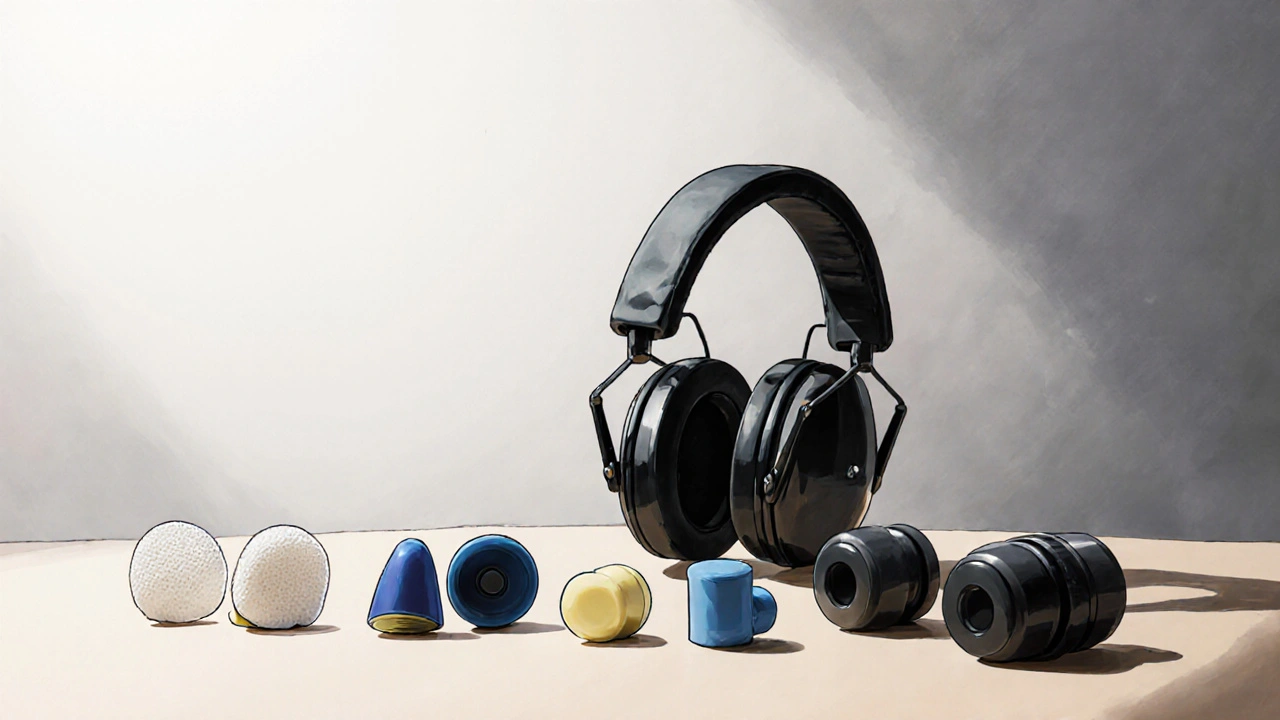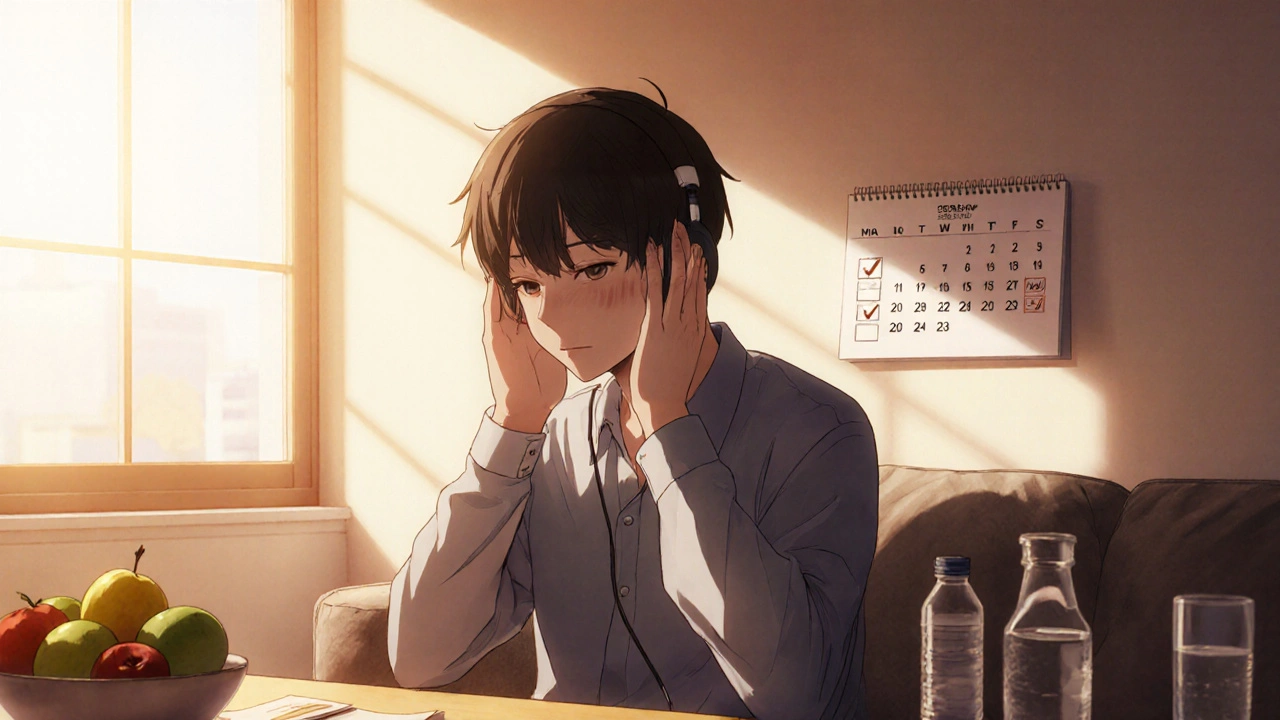Hearing Protection Selector
Protect Your Ears
Select your noise environment to get personalized hearing protection recommendations based on WHO guidelines and Noise Reduction Ratings (NRR).
Recommended Protection
Required NRR
Safe dB Level
Recommended Options
Every day we expose our ears to sounds that can chip away at our ability to hear. Whether it’s blasting music on a commute, using power tools at work, or simply forgetting to lower the TV volume, these habits add up fast. This guide walks you through practical steps to prevent hearing loss, explains why the damage happens, and shows how to pick the right protection for every situation.
What Exactly Is Hearing Loss?
When we talk about hearing loss is a partial or total inability to perceive sounds, ranging from mild difficulty hearing conversations to complete deafness, we’re looking at a condition that affects millions worldwide. The World Health Organization estimates that over 1.5 billion people live with some degree of hearing impairment, and that number is rising as noisy environments become the norm.
Two of the most common forms are:
- Noise‑induced hearing loss (damage caused by exposure to loud sounds over time)
- Age‑related hearing loss (gradual loss that occurs as part of the aging process, also known as presbycusis)
Both share a common denominator: the hair cells inside the cochlea get overstressed and can’t recover.
Why Do Our Ears Get Damaged?
The primary culprits are:
- Loud noise - Measured in decibels (dB), a level above 85 dB for extended periods starts to harm the inner ear. A chainsaw, a live‑music concert, or even a busy street can hit 90‑100 dB.
- Ototoxic medications - Certain antibiotics, chemotherapy drugs, and high‑dose aspirin can be toxic to the auditory nerve. These are known as ototoxic medications (drugs that can damage inner‑ear structures).
- Ear infections - Chronic middle‑ear infections can scar the eardrum and middle‑ear bones, leading to conductive hearing loss.
Understanding the decibel (a logarithmic unit used to measure sound intensity) scale helps you gauge risk. For perspective, normal conversation sits around 60 dB, city traffic at 85 dB, and a rock concert can exceed 110 dB.
Everyday Habits That Keep Your Ears Safe
Small changes protect you without sacrificing enjoyment:
- Volume control - Follow the 60/60 rule: keep headphones at no more than 60 % of maximum volume and limit listening sessions to 60 minutes.
- Use noise‑cancelling headphones - By reducing background noise, you can listen at lower volumes. Noise‑cancelling headphones (headsets that emit anti‑phase sound waves to cancel ambient noise) are especially useful on planes or in open‑office spaces.
- Take listening breaks - Give your ears a 5‑minute rest every hour. The auditory system needs time to recover from stimulation.
- Limit exposure to loud environments - If you’re at a concert, step away from the speakers every now and then, or wear ear protection.
Choosing the Right Ear Protection
When you can’t avoid noise, proper protection is a must. The three main categories are earplugs, earmuffs, and custom‑molded devices. Here’s a quick comparison:
| Type | Noise Reduction Rating (NRR) | Comfort | Typical Use | Cost (AU$) |
|---|---|---|---|---|
| Foam earplugs | 22‑33 dB | High (compress‑and‑expand) | Concerts, sleeping, DIY projects | 2‑5 |
| Silicone earplugs | 20‑25 dB | Medium (moldable) | Swimming, industrial work | 10‑15 |
| Acoustic earmuffs | 25‑30 dB | Medium‑high (over‑the‑ear) | Construction sites, shooting ranges | 30‑80 |
| Custom‑molded plugs | 25‑35 dB | Very high (personal fit) | Musicians, frequent flyers | 80‑150 |
For most people, a good pair of foam earplugs works fine for occasional loud events. If you’re a musician or spend a lot of time in noisy settings, investing in custom‑molded plugs pays off in comfort and consistent protection.
Workplace Safety and Legal Standards
Employers are required to follow safety regulations that limit employee exposure to harmful noise. In Australia, Safe Work Australia adopts the OSHA (Occupational Safety and Health Administration standards, used as a reference for noise exposure limits)-style guidelines, recommending an 8‑hour exposure limit of 85 dB.
The World Health Organization (WHO) issued WHO guidelines on noise (global recommendations for safe listening levels in recreational settings) in 2023, urging a maximum of 100 dB for personal audio devices and encouraging the use of hearing protection in venues louder than 100 dB.
If your job involves sustained loud noise, request a hearing‑conservation program, regular audiograms, and appropriate protective gear.

How to Spot Early Signs and When to Seek Help
Detecting a problem early can prevent permanent damage. Watch for:
- Difficulty following conversations in a quiet room.
- Frequent requests to repeat information.
- Ringing or buzzing sounds that aren’t there - known as tinnitus (perceived sound, often a ringing, without external source).
- Feeling of fullness in the ear.
If any of these symptoms appear, schedule an appointment with an audiologist. An audiogram (a chart that maps hearing sensitivity across frequencies) will pinpoint which frequencies are affected and guide the next steps.
Lifestyle Tweaks That Support Ear Health
Beyond noise control, a few lifestyle choices boost hearing resilience:
- Balanced diet - Nutrients like omega‑3 fatty acids, magnesium, and antioxidants help maintain inner‑ear cells.
- Regular exercise - Improves blood circulation to the cochlea.
- Avoid smoking - Tobacco constricts blood vessels, reducing oxygen flow to auditory structures.
- Limit ototoxic drug use - Discuss alternatives with your doctor if you’re prescribed high‑risk medications.
Combine these habits with the protective measures above and you’ll give your ears the best chance to stay sharp for decades.
Quick Checklist for Everyday Ear Protection
- Keep personal audio devices below 60 % volume.
- Take a 5‑minute hearing break every hour.
- Use foam earplugs at concerts or noisy bars.
- Wear noise‑cancelling headphones on flights.
- Ask your employer for a hearing‑conservation plan if you work in a loud environment.
- Schedule an audiogram if you notice any warning signs.
- Maintain a heart‑healthy diet and stay active.
How loud is too loud for everyday listening?
Sounds above 85 dB sustained for more than an hour can start causing damage. For personal devices, aim for 60 % of max volume and keep sessions under 60 minutes.

Can earplugs cause hearing loss if used incorrectly?
If they’re inserted too shallowly, they won’t block enough noise; too deep can irritate the ear canal. Follow the manufacturer’s instructions and replace disposable plugs regularly.
Is tinnitus always a sign of permanent hearing loss?
Not always. Tinnitus can be temporary after a loud event, but persistent ringing warrants a professional check‑up.
What is the best ear protection for musicians?
Custom‑molded earplugs with a moderate NRR (around 20 dB) preserve sound quality while reducing harmful peaks.
How often should I get an audiogram?
If you’re exposed to loud environments regularly, an annual test is wise. Otherwise, a baseline check in your 30s and follow‑up every five years works.


Celeste Flynn
October 23, 2025 AT 12:23Listening to music at a safe volume is the easiest habit you can adopt to protect your hearing. The 60/60 rule works not just for headphones but also for earbuds that sit deep in the ear canal. When you keep the volume below sixty percent of the device’s maximum you reduce the risk of damaging the delicate hair cells in the cochlea. It also means you’re less likely to develop tinnitus, that annoying ringing that can linger after a concert. Taking a five‑minute break every hour gives the auditory nerves a chance to recover from continuous stimulation. Even a short pause can lower the overall decibel exposure for the day. Noise‑cancelling headphones are a game changer on planes or in open‑office environments because they cut out background chatter. By blocking ambient noise you don’t have to crank up the music to be heard. Foam earplugs are cheap, disposable, and they block up to thirty decibels when inserted correctly. For workers on construction sites, acoustic earmuffs with a high NRR provide consistent protection over long shifts. Custom‑molded plugs might seem pricey but they stay comfortable for musicians who need to hear the nuance of their instruments. A balanced diet rich in omega‑3 fatty acids, magnesium, and antioxidants supports the health of the inner ear. Regular aerobic exercise improves blood flow to the cochlea, helping it repair minor damage. Avoiding smoking also keeps the tiny blood vessels in the ear from narrowing. If you ever notice you’re asking people to repeat themselves, schedule an audiogram before the loss becomes permanent. By weaving these habits into daily life you give your ears the best chance to stay sharp for decades.
CASEY PERRY
October 24, 2025 AT 16:10Acoustic trauma stems from prolonged exposure to sound pressure levels exceeding 85 dB, prompting irreversible mechanotransduction impairment. Implementing the 60/60 protocol mitigates cochlear hair‑cell fatigue by limiting both intensity and duration of auditory stimuli. Personal protective equipment, such as high‑NRR foam inserts, attenuates incident SPLs by up to 30 dB, conforming to OSHA occupational safety thresholds. Regular audiometric monitoring facilitates early detection of threshold shifts, ensuring timely intervention.
Naomi Shimberg
October 25, 2025 AT 19:57While the guide extols the virtues of earplugs, one must acknowledge that excessive attenuation can stifle essential environmental cues, potentially compromising safety. Moreover, the romanticization of “quiet” overlooks the cultural significance of sound in communal rituals.
kenny lastimosa
October 27, 2025 AT 04:17It is curious how society glorifies relentless noise yet treats hearing loss as an inevitable afterthought. Perhaps if we valued silence as a counterpart to speech, we would design our cities with acoustic sanctuaries rather than perpetual chatter. The notion that we must “just get used to it” feels like an admission of collective complacency. In the grand scheme, protecting our ears is an act of respecting the fragile balance of the human experience. Still, who will champion that balance when profit drives louder venues?
Dante Russello
October 28, 2025 AT 08:03Hey folks, it’s great that you’re thinking about ear health, and there are a few simple steps you can start right now, without any special equipment. First, try the 60/60 rule with your earbuds, keep the volume low, and take regular breaks, even a short five‑minute pause can make a difference. Second, consider investing in a pair of noise‑cancelling headphones, they’ll block out the background hum, so you won’t need to crank up the music. Third, when you’re at concerts or loud bars, pop in a cheap foam earplug, they’re cheap, effective, and disposable. Remember, regular check‑ups with an audiologist can catch early signs, and many workplaces even offer hearing‑conservation programs, so don’t hesitate to ask. By sharing these tips, we can all keep our conversations clear and our lives full of sound.
James Gray
October 29, 2025 AT 09:03Yo everyone, just wanted to say these ear tip tricks are definetly worth trying, they ain't that hard to get into. I tried the 60/60 rule while gaming and felt less fatigue, plus my buddy swears his new earbuds sound cleaner. Keep it up, we’ll all hear better together!
Scott Ring
October 30, 2025 AT 15:37Listening to music is a universal language, and protecting our ears ensures we don’t miss a beat of that shared rhythm. I’ve seen friends who ignored early signs end up with permanent loss, which is heartbreaking. Simple habits like volume checks and earplugs can keep those memories alive. Let’s look out for each other, especially in noisy festivals where the vibe is high but safety matters. Together we can enjoy the soundscape without sacrificing health.
Shubhi Sahni
October 31, 2025 AT 18:00Friends, I want to emphasize how important it is to schedule regular audiograms, especially if you’re exposed to loud environments, as early detection can prevent irreversible damage, and many clinics even offer free screenings, so take advantage of those opportunities. Additionally, maintaining a balanced diet rich in antioxidants, omega‑3s, and magnesium supports your inner ear health, and regular exercise improves circulation to the cochlea, further protecting your hearing. When using earplugs, ensure they are inserted properly, not too shallow, not too deep, and replace disposable ones frequently; otherwise, you risk irritation or reduced effectiveness. Lastly, advocate for your workplace’s hearing‑conservation program, because a safe environment benefits everyone, and compliance with safety standards is a right, not a privilege. By sharing these practices, we foster a community that values both sound and safety.
Danielle St. Marie
November 1, 2025 AT 21:47Honestly, if you’re still listening at full blast, you’re basically courting deafness 🧨. Elite audiophiles know that discretion in volume is a sign of refined taste 🎧. Get it together and respect your ears 🙄.
keerthi yeligay
November 2, 2025 AT 21:23Did you kno that even short daily breaks can lower the risk of tinnitus? Try the 5‑minute pause rule, it’s simple and effective. Your ears will thank you.
Peter Richmond
November 3, 2025 AT 23:47Implementing routine hearing checks and proper ear protection is essential for long‑term auditory health. Encourage colleagues to adopt the 60/40 guideline for a safer workplace. Together we can reduce noise‑induced hearing loss.
Bonnie Lin
November 4, 2025 AT 22:00Sound safety matters.
Shan Reddy
November 5, 2025 AT 23:00I appreciate the thorough guide, especially the clear tables on ear‑plug options. The advice on taking regular breaks fits well with my daily routine. Keep posting useful health tips.